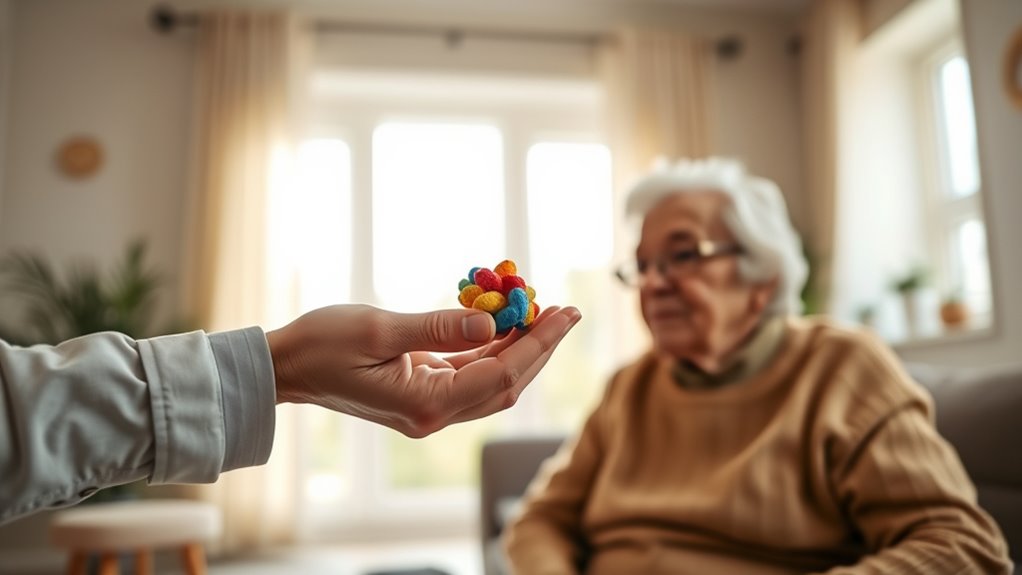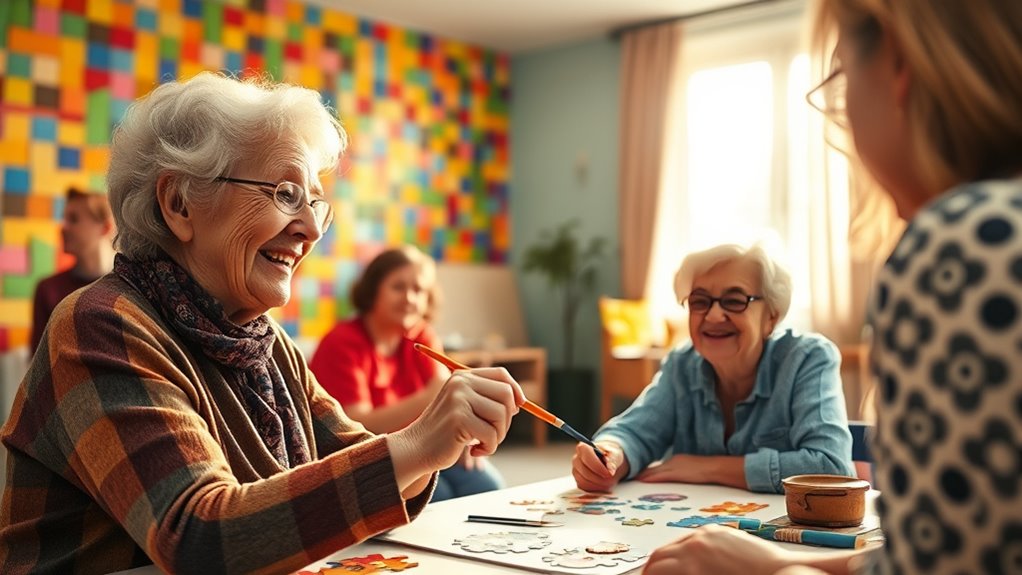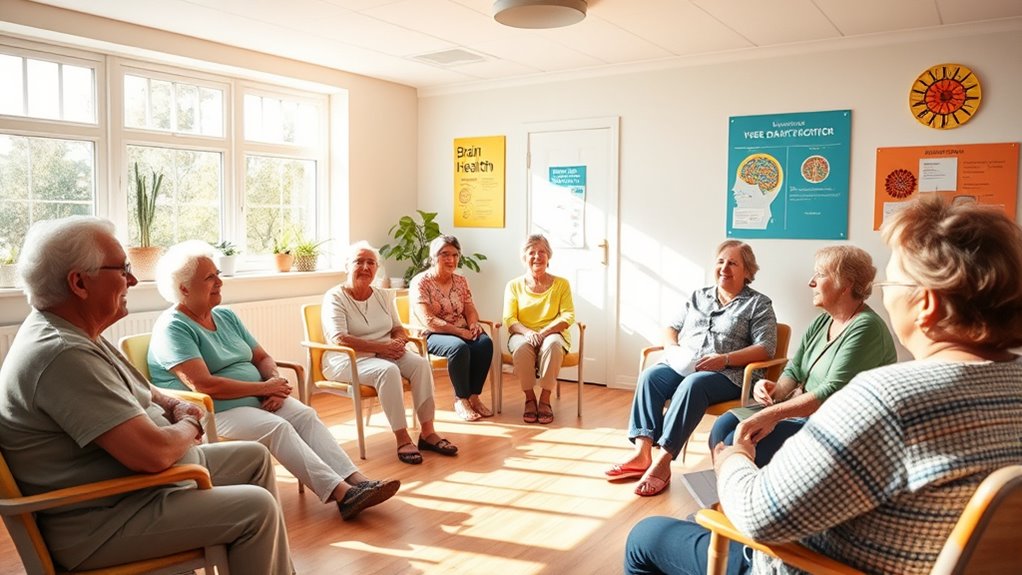Remotivation therapy helps combat apathy by engaging you through personalized activities that match your interests and motivations. It uses techniques like motivational interviewing, sensory stimulation, and behavioral activation to boost your emotional engagement and motivation. This approach builds trust and encourages participation, which can improve your mood, activity levels, and daily functioning. If you want to understand how these strategies work together to help restore your emotional engagement, keep exploring further.
Key Takeaways
- Remotivation therapy personalizes activities to counteract apathy by boosting intrinsic motivation and emotional engagement.
- Techniques like motivational interviewing and sensory stimulation are used to rekindle interest and participation.
- Tailoring interventions to individual preferences enhances engagement and reduces resistance in apathetic individuals.
- Digital tools and future technologies facilitate accessible, culturally sensitive approaches to address apathy effectively.
- Evidence shows that remotivation strategies improve mood, activity levels, and social participation across various neurological and mental health conditions.
Understanding Apathy and Its Impact on Daily Life

Have you ever wondered how a lack of motivation can quietly take over your daily routines? Apathy often feels like an invisible barrier, making it hard to engage with activities you once enjoyed. It can diminish your emotional intelligence, leaving you less aware of your feelings and those of others. Without recognition of these emotions, social support becomes less effective, further deepening your sense of disconnect. Over time, apathy can lead to withdrawal, impacting relationships and daily tasks. Understanding this emotional numbness is essential because it highlights how intertwined your feelings, social interactions, and motivation truly are. Recognizing these signs early allows you to seek strategies that can help reignite your emotional engagement and rebuild your connection to daily life. Additionally, addressing underlying issues such as emotional awareness can be crucial in overcoming apathy and restoring motivation.
Core Principles of Remotivation Therapy

Remotivation Therapy is built on a person-centered approach that respects individual interests and needs. You’ll focus on creating engaging activities that spark motivation and participation. By tailoring strategies to each person, you can help reignite their enthusiasm for daily life. Incorporating individualized care ensures that interventions are meaningful and effective for each person.
Person-Centered Approach
The core principles of the Person-Centered Approach emphasize respecting each individual’s unique needs, preferences, and life history. You focus on building trust and understanding through active listening and empathetic engagement. Motivational interviewing plays a key role by helping you explore your own motivations and barriers in a supportive environment. Peer support is also integral, allowing you to connect with others who share similar experiences, fostering a sense of belonging and encouragement. This approach recognizes that meaningful change comes from within, guided by your personal goals and values. By honoring your individuality, you’re empowered to participate actively in your recovery, making the therapy tailored and respectful of your unique journey. Incorporating mindfulness techniques, such as deep breathing exercises, can further enhance your emotional resilience and self-awareness throughout this process.
Engaging Activity Strategies
Building on the person-centered approach, engaging activity strategies in Remotivation Therapy focus on harnessing meaningful activities to inspire motivation and restore a sense of purpose. You encourage participation by using motivational interviewing techniques, helping individuals explore their interests and values. Incorporating sensory stimulation, such as tactile, visual, or auditory cues, can enhance engagement and evoke positive responses. These activities are tailored to each person’s preferences, making them more compelling and relevant. By combining motivational interviewing with sensory stimulation, you create a supportive environment that sparks curiosity and rekindles interest. Incorporating unique flavors like seasonal fruit blends from local gelato spots can make activities more appealing and memorable. This strategy helps break through apathy, fostering a sense of achievement and connection, ultimately motivating individuals to pursue activities that bring fulfillment and joy.
Techniques and Activities Used in Remotivation Interventions

Several techniques and activities are central to effective remotivation interventions, aiming to re-engage individuals and foster their sense of purpose. Motivational interviewing is a key method, helping you explore and resolve ambivalence about change by encouraging open dialogue and reinforcing your intrinsic motivations. Cognitive restructuring is another essential activity, guiding you to identify and challenge negative thought patterns that contribute to apathy. These techniques help you build awareness, boost self-efficacy, and develop a positive outlook toward re-engagement. You might also participate in goal-setting exercises or personalized activities that align with your interests. Incorporating popular anime movies and animated films that touch hearts can provide emotional inspiration and motivation during your journey. Together, these methods create a supportive environment that promotes motivation, restores purpose, and helps you regain enthusiasm for daily activities.
Evidence Supporting Effectiveness in Various Conditions

Research shows that Remotivation Therapy can boost motivation across different disorders, helping individuals reconnect with activities. You’ll find that it promotes greater engagement and participation in daily life. Clinical trials consistently support its effectiveness, demonstrating positive outcomes in diverse settings. Additionally, incorporating essential oils may enhance relaxation and emotional well-being during therapy sessions.
Improved Motivation Across Disorders
Evidence shows that Remotivation Therapy can effectively boost motivation across a wide range of mental health and neurological conditions. It helps break through motivational barriers by tailoring interventions to each individual’s needs, ensuring therapy customization. This personalization addresses unique challenges, making it easier to engage patients and promote sustained effort. Whether dealing with depression, schizophrenia, or neurological disorders like Parkinson’s, Remotivation Therapy has demonstrated positive outcomes. By focusing on individual goals and preferences, it reduces resistance and enhances intrinsic motivation. The therapy’s flexibility allows you to adapt strategies for different conditions, maximizing effectiveness. As a result, patients experience a renewed sense of purpose and engagement, which can profoundly improve overall functioning and quality of life across diverse clinical populations. Incorporating raw food principles into therapy programs can also support physical health and energy levels, further reinforcing motivation and well-being.
Enhanced Engagement and Activity
Enhanced engagement and activity are central goals of Remotivation Therapy, and numerous studies show it effectively increases participation across various conditions. By conducting a thorough motivation assessment, you can identify what drives each individual, allowing for activity customization tailored to their interests and needs. This personalized approach helps overcome apathy by making activities more meaningful and relevant, which encourages sustained involvement. Evidence indicates that when activities align with personal preferences, patients are more likely to engage actively, improving overall participation. Whether working with elderly adults, individuals with depression, or those with neurological conditions, the combination of motivation assessment and activity customization proves vital. This targeted strategy promotes greater enthusiasm, improved mood, and a more vibrant, participatory experience. Additionally, understanding the influence of astrology and personality traits can provide insights into individual motivations and preferences, further enhancing engagement strategies.
Evidence From Clinical Trials
How do we comprehend that Remotivation Therapy truly works across different populations? Clinical trials provide compelling evidence, highlighting improvements in motivation and engagement. Studies in depression, dementia, and stroke recovery show that techniques like motivational interviewing and cognitive restructuring boost purpose and activity levels. These interventions help reshape negative thought patterns, fostering hope and resilience. The following table illustrates the impact across conditions:
| Condition | Key Outcomes | Notable Technique |
|---|---|---|
| Depression | Increased activity levels | Motivational interviewing |
| Dementia | Improved alertness | Cognitive restructuring |
| Stroke Recovery | Enhanced participation | Motivation-focused strategies |
| Parkinson’s Disease | Elevated mood and drive | Combined therapeutic approaches |
| Post-Surgery Rehab | Faster progress | Personalized remotivational plans |
Additionally, incorporating attention into therapy sessions can significantly enhance patient engagement and outcomes.
Integrating Remotivation Strategies Into Treatment Plans

To effectively incorporate remotivation strategies into treatment plans, you need to tailor interventions to each individual’s unique interests and motivational triggers. Start with motivational interviewing to explore personal values and enhance intrinsic motivation. Use behavioral activation to encourage engagement in meaningful activities, gradually reducing apathy. Focus on these key steps:
- Identify activities aligned with the person’s interests to boost motivation.
- Apply motivational interviewing techniques to foster self-awareness and commitment.
- Incorporate incremental goals to sustain engagement and measure progress.
Additionally, selecting appropriate materials and tools can facilitate successful implementation of these strategies and support sustained motivation.
Future Directions and Innovations in Remotivation Approaches

Advancements in technology and a deeper understanding of motivational psychology are driving innovative approaches to remotivation therapy. Technological innovations, such as virtual reality and mobile apps, enable personalized and engaging interventions that reach diverse populations. These tools can adapt to individual needs, making therapy more effective and accessible. Additionally, cultural considerations are becoming central to future strategies; tailoring interventions to align with cultural values and beliefs ensures greater acceptance and engagement. Researchers are exploring ways to integrate cultural competence into digital platforms, enhancing the relevance of remotivation efforts worldwide. As technology evolves, so will the ability to create more nuanced, inclusive approaches that address the unique motivational barriers faced by different communities, ultimately improving outcomes in remotivation therapy.
Frequently Asked Questions
How Long Does It Typically Take to See Improvements With Remotivation Therapy?
You’re wondering how long it takes to see progress with therapy. Typically, therapy duration varies depending on individual needs, but most people notice initial improvements within a few weeks. Progress milestones often include increased motivation, engagement in activities, and improved mood. Consistency is key, and some may see faster results, while others need more time. Regular sessions and open communication help track progress and adjust therapy to meet your goals effectively.
Can Remotivation Therapy Be Adapted for Children or Adolescents?
You can adapt remotivation therapy to enhance child engagement and boost adolescent motivation. Tailoring activities to their interests makes therapy more effective, encouraging participation and enthusiasm. You’ll want to use age-appropriate strategies, incorporate playful elements, and involve family support. This personalized approach helps children and adolescents reconnect with their goals, fostering motivation and improving their overall well-being. With patience and creativity, remotivation therapy can be a powerful tool for young populations.
Are There Any Risks or Contraindications Associated With Remotivation Interventions?
Think of remotivation interventions as a delicate dance, where missteps can lead to unintended consequences. You should be aware of medical contraindications that might make certain activities risky, and psychological risks that could deepen feelings of helplessness. Always evaluate each individual’s health status and mental state carefully, ensuring that the therapy enhances motivation without causing harm. When properly guided, these interventions can be a safe, uplifting step toward renewed engagement.
How Does Remotivation Therapy Differ From Other Motivational or Behavioral Therapies?
You might wonder how remotivation therapy differs from other motivational or behavioral therapies. It uniquely uses personalized approaches tailored to your interests and needs, making it more engaging. Additionally, it integrates technology to deliver interventions remotely, increasing accessibility. Unlike traditional methods, this approach emphasizes ongoing support through digital tools, helping you stay motivated and connected. This combination makes remotivation therapy a flexible, innovative option to boost your engagement and emotional well-being.
What Training Is Required for Practitioners to Effectively Deliver Remotivation Therapy?
To effectively deliver remotivation therapy, you need specialized training in motivational interviewing and cognitive training techniques. You should understand how to engage clients, foster motivation, and tailor interventions to individual needs. Training programs often include workshops, supervised practice, and ongoing education to develop your skills. This preparation helps you support clients in overcoming apathy, encouraging active participation, and promoting meaningful engagement in their recovery process.
Conclusion
Remotivation therapy acts like a spark that ignites your motivation, helping you reconnect with daily activities and purpose. By embracing its core principles and techniques, you can rediscover joy and engagement in life. Just as a steady flame brightens a dark room, this approach illuminates your path toward better well-being. Keep exploring and integrating these strategies—they could be the key to transforming your experience with apathy into renewed energy.









